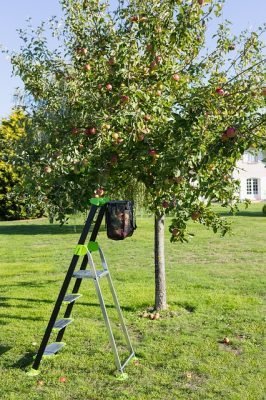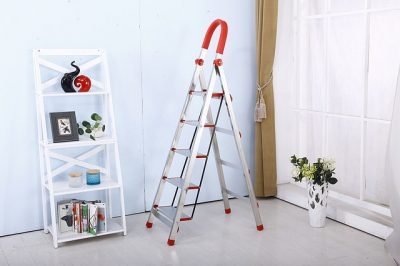 There comes a point in every homeowner’s life when they have to reach for a high place, and a chair or step stool isn’t going to cut it. From reaching into high cupboards and cabinets, changing out the curtains or lightbulbs in high-ceilinged rooms or above the staircase, to cleaning out rain gutters, a ladder is one of those pieces of hardware that may spend an interminable amount of time in storage, but is critically useful the times it gets pulled out.
There comes a point in every homeowner’s life when they have to reach for a high place, and a chair or step stool isn’t going to cut it. From reaching into high cupboards and cabinets, changing out the curtains or lightbulbs in high-ceilinged rooms or above the staircase, to cleaning out rain gutters, a ladder is one of those pieces of hardware that may spend an interminable amount of time in storage, but is critically useful the times it gets pulled out.
But this does not mean any old ladder would do, or that the same ladder is the right choice for every home improvement and maintenance job. The American Academy of Orthopedic Surgeons estimates that there are roughly 500,000 ladder-related accidents and injuries annually, of which 300 are fatal. As you’d expect, having yourself off the ground supported entirely by a frame of metal or fiberglass demands caution and a good grasp of the dos and don’ts, and picking the right type of ladder or being aware of how to use one can help prevent almost entirely avoidable accidents.
The problem, usually, is that many are not aware of exactly what kind of ladder is best suited to the task at hand, and how they can use it safely. Prevention, as the saying goes, is better than cure, so why risk our wellbeing trying to make do with any cheap ladder or a ladder not fit for the job? Here’s what you need to know before deciding on the ideal ladder for your home.
Material
Typically, ladders are available made of wood, fiberglass or aluminum, but wooden ladders are pretty much going out of vogue. They don’t fare as well in storage, and rotting wood and loose hinges pose inherent safety hazards, making them less practical than their more durable counterparts.
Fiberglass is a great option if you’re working with or around electrical wires. Aluminum and other metal ladders would conduct electricity and pose serious, if not life-threatening, electrocution risks, but for jobs that don’t involve wires, they’re a great option to have around the home for their resilience, durability and lightweight constructs. Aluminum ladders, all in all, are easier to carry about, especially if you need one for jobs that require moving from place to place, like trimming down your hedges or repainting the sides of your house.
Ladder Height
 Getting this part wrong is in many cases the main factor behind ladder-related accidents and injuries. The ladder you have on hand, bought without exploring your options or are trying to repurpose for a different use than what it was originally purchased for might just not be the right height for cleaning out your rain gutters or replacing that lightbulb over the staircase that’s finally burnt out.
Getting this part wrong is in many cases the main factor behind ladder-related accidents and injuries. The ladder you have on hand, bought without exploring your options or are trying to repurpose for a different use than what it was originally purchased for might just not be the right height for cleaning out your rain gutters or replacing that lightbulb over the staircase that’s finally burnt out.
Before going in to purchase a ladder, it’s very important to have an idea of the height coverage you’ll be needing. If you’re going to be cleaning out gutters, replacing roof tiling or maintaining your RV, an extension ladder which telescopes, with the height capable of being extended rung by rung, is recommended to have at least 7 to 10 feet of clearance above the highest contact point. This is important to ensure you have the proper reach, without climbing too high up the ladder and causing it to destabilize, making you lose your balance. A term to keep in mind when it comes to extension ladders is the ‘highest standing level’ – this refers to how high up a ladder you can be without risking a loss of balance, and for extension ladders, this is four rungs from the top. For step ladders, the highest standing level is two steps from the top.
In fact, the highest standing level factors into your calculations for how high the right ladder should be. If you’re looking for a step ladder, estimate the height you need to reach, and deduct about two feet from this number to get the ideal height for your step ladder.
For extension ladders, calculate the height you need to reach while taking into account that the ladder will be used at an angle, leaning against the side of the surface you’re trying to reach. The 1 in 4 rule specifies that this angle needs to be around 75 degrees, or a fourth of the ladder’s height. You can get mathsy here and use the Pythagoras Theorem principle to work out the ideal height of the ladder (the length of the slanting line on a right-angled triangle) given the 75 degree angle, the height of the highest contact point and the distance on the ground between the ladder and the wall – or, to keep it simple, multiply the height of the highest contact point by 1.04, and add on a meter. Remember, also, that extension ladders come in sections, usually two overlapping segments – this means that fully extended, these ladders aren’t true to size, i.e. although both segments of the ladder may be 12 feet, the fully extended length of the ladder will be shorter than 24 feet. This is necessary, since the extra overlap gives stability and support to ladders and is safer to use for painting, roof tiling and cleaning out rain gutters.
Though we’ve touched on this before, we’ll stress again the importance of picking the right height for a ladder depending on the job – too short, and you risk losing your balance and hurting yourself as you struggle to reach; too high, and you’re likely to be too far away from the surface you’re trying to reach since you’re lower down the ladder, also increasing the likelihood of accidents.
Duty rating
Duty rating refers to the weight capacity a ladder is capable of holding, and is another critical consideration when going about picking the right ladder for you. The appropriate duty rating depends not only on whether the ladder can support your weight, but also the weight of all your equipment and tools, as well as the extra digits added on by your work clothes or protective gear. So as not to destabilize yourself and your ladder, it’s a good idea to weigh yourself with your tools and clothing on, to get an idea of the load capacity you’re going to need for a ladder. Duty ratings typically classify ladders into 5 grades, from Light Duty to Extra Heavy Duty usage with a weight capacity range from 200 to 375 pounds.
Ladder types
 We’ve already discussed extension and step ladders, but we are spoilt for choice when it comes to ladder variety. Generally, single-sided ladders are good for quick-fixes around the home, though double-sided ladders offer more stability and are the better choice if you need to get a good measure of elevation for the task at hand, for example when trimming hedges. A great multipurpose ladder can also let you adjust the heights of either side of an A-frame stepladder separately, so it can be used in more tricky areas like stairs if you need to reach a height above it.
We’ve already discussed extension and step ladders, but we are spoilt for choice when it comes to ladder variety. Generally, single-sided ladders are good for quick-fixes around the home, though double-sided ladders offer more stability and are the better choice if you need to get a good measure of elevation for the task at hand, for example when trimming hedges. A great multipurpose ladder can also let you adjust the heights of either side of an A-frame stepladder separately, so it can be used in more tricky areas like stairs if you need to reach a height above it.